Yamaha’s potent yet manageable FZ8 is enough to make its paternal grandfather, the R1, blush with pride. As the latest beneficiary from Yamaha’s repli-racer genetic stock, the 779cc inline-Four is endowed with some of Yamaha’s most inspired sporting technology which should serve it well in its life as an everyday sporting Standard.
The FZ8’s DNA has roots in Yamaha’s premier sportbike, the YZF-R1. The current FZ1’s engine was derived from the pre-crossplane R1. The new offspring inherits the FZ1’s R1-inspired alloy perimeter frame, its chassis geometry, some engine components, as well as many design elements from its compact and efficient engine.
Since we’ve already covered most of the FZ8’s tech details in our preview article, we’ll focus on why Yamaha thinks this bike is a good idea now, and what it’s like to ride.
Why it’s Here
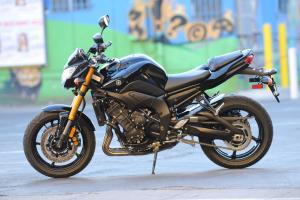
Yamaha says after extensive market research, it decided to import the previously Euro-only FZ8 to the U.S. and Canada for 2011 to span the chasm between 600cc and 1000cc street-oriented sportbikes – while for now bringing its half-faired Fazer 8 sibling only to the Canadians and Euros.
Since 2005, “sportbikes,” including hypersports, sporty bikes, and sport-tourers, have comprised about 20% of all U.S. motorcycle sales, Yamaha says, second only to cruisers, which account for more than 40%.
In mining demographic data in these recessionary times, Yamaha sees a glint of gold in a trend toward buyers who want one do-it-all sportbike. Some of these buyers will be replacing existing bikes, or trading up from smaller bikes, while at the same time there’s a 9% decline in those seeking an additional bike to add to a stable.
Among 53 buyer preferences Yamaha researched, high on the list were rider positioning, attainable price, large-enough displacement, color and graphics, physical size, ease of touching feet to the ground, light and maneuverable handling, fuel economy, and more.
In short, the mission was to create a versatile and economical bike that comes closer than ever to letting riders with sporting inclinations have their cake and eat it too.
After sampling an FZ8 for nearly 130 miles, in conditions varying from highways to canyons to around town, we would say that this new machine could certainly fit the bill.
How it Works
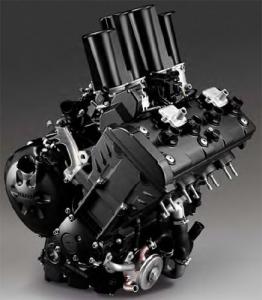
Depending on whether you’re feeling like a glass-half-full or half-empty kind of person, you could either say the FZ8 feels like a 600 – but with power like a strong 750 – or you could say it’s like a detuned, lighter FZ1.
But while the FZ8’s 12.0:1 compression, fuel-injected engine shares the FZ1’s crankcase, 53.6mm stroke and basic architecture, it is not accurate to call it a sleeved-down version of the 11.5:1 compression FZ1 mill.
To begin with, the FZ8’s four-valve-per cylinder head is all new, as are its shorter lift and duration camshafts, and new intake funnels – 125mm-long for cylinders 1 and 4, and 150mm-long for cylinders 2 and 3 – that help broaden its powerband.
Coupled with its 35mm throttle body – 10mm narrower than the FZ1’s – these features enhance torque while still allowing for a respectable top-end rush.
Yamaha doesn’t make power claims, but the FZ8’s 11,500-max-rpm mill reportedly peaks at around 105 hp, and 61 ft-lb torque when measured at the crankshaft.
Speaking of which, the crankshaft is modeled on the FZ1’s but weighs 30% less, which Yamaha says helps it still rev quickly, while positively influencing handling.
How? Although the FZ8’s 467-lb curb weight is only 20 lbs lighter than its big brother, Yamaha says decreased crankshaft inertial mass can be discerned in the way the bike transitions from side to side. Coupled with a 10mm-narrower rear tire, Yamaha says the FZ8 feels 50 lbs lighter. We didn’t have an FZ1 to compare it to, but it’s at least sure the FZ8 exhibits a nimbleness that belies its mass.
The FZ8’s DNA has roots in Yamaha’s premier sportbike, the YZF-R1. The current FZ1’s engine was derived from the pre-crossplane R1. The new offspring inherits the FZ1’s R1-inspired alloy perimeter frame, its chassis geometry, some engine components, as well as many design elements from its compact and efficient engine.
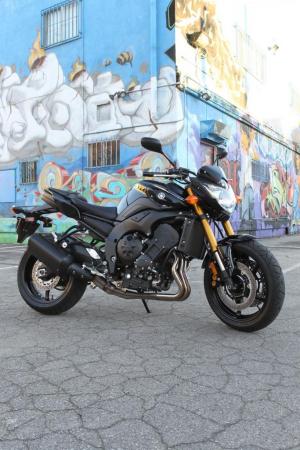 |
Why it’s Here

Yamaha says after extensive market research, it decided to import the previously Euro-only FZ8 to the U.S. and Canada for 2011 to span the chasm between 600cc and 1000cc street-oriented sportbikes – while for now bringing its half-faired Fazer 8 sibling only to the Canadians and Euros.
Since 2005, “sportbikes,” including hypersports, sporty bikes, and sport-tourers, have comprised about 20% of all U.S. motorcycle sales, Yamaha says, second only to cruisers, which account for more than 40%.
In mining demographic data in these recessionary times, Yamaha sees a glint of gold in a trend toward buyers who want one do-it-all sportbike. Some of these buyers will be replacing existing bikes, or trading up from smaller bikes, while at the same time there’s a 9% decline in those seeking an additional bike to add to a stable.
Among 53 buyer preferences Yamaha researched, high on the list were rider positioning, attainable price, large-enough displacement, color and graphics, physical size, ease of touching feet to the ground, light and maneuverable handling, fuel economy, and more.
In short, the mission was to create a versatile and economical bike that comes closer than ever to letting riders with sporting inclinations have their cake and eat it too.
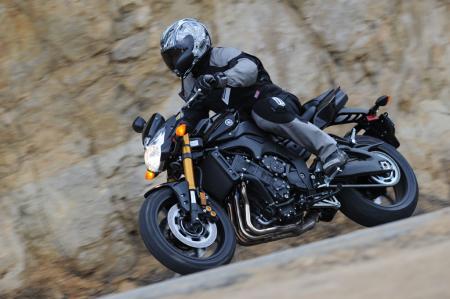 |
How it Works

Depending on whether you’re feeling like a glass-half-full or half-empty kind of person, you could either say the FZ8 feels like a 600 – but with power like a strong 750 – or you could say it’s like a detuned, lighter FZ1.
But while the FZ8’s 12.0:1 compression, fuel-injected engine shares the FZ1’s crankcase, 53.6mm stroke and basic architecture, it is not accurate to call it a sleeved-down version of the 11.5:1 compression FZ1 mill.
To begin with, the FZ8’s four-valve-per cylinder head is all new, as are its shorter lift and duration camshafts, and new intake funnels – 125mm-long for cylinders 1 and 4, and 150mm-long for cylinders 2 and 3 – that help broaden its powerband.
Coupled with its 35mm throttle body – 10mm narrower than the FZ1’s – these features enhance torque while still allowing for a respectable top-end rush.
Yamaha doesn’t make power claims, but the FZ8’s 11,500-max-rpm mill reportedly peaks at around 105 hp, and 61 ft-lb torque when measured at the crankshaft.
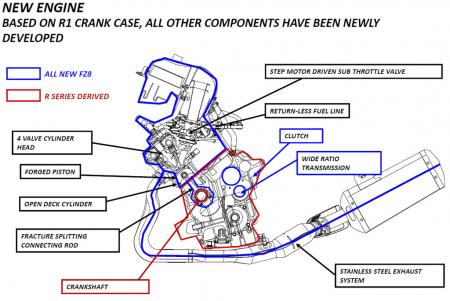 |
 |  |
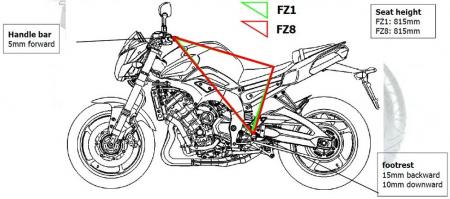 |
IT'S MY HOBBY
উত্তরমুছুনya!!!!jompash!!
উত্তরমুছুনmy name is yamaha!1
উত্তরমুছুন